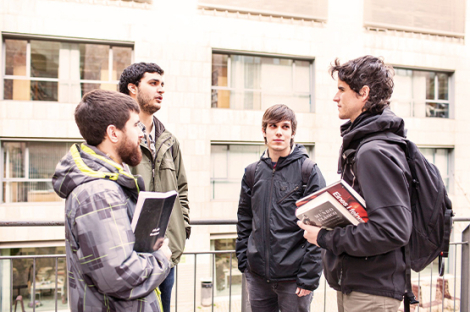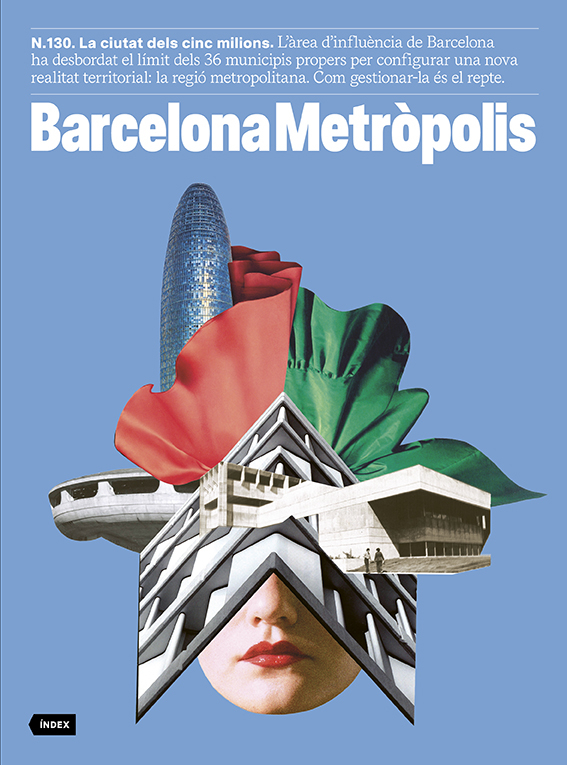A city void of language?
- Culture Folder
- Trends
- Apr 24
- 14 mins

As the new century unfolds, the capital of Catalonia finds itself noticeably shedding the most defining aspect of its identity: its language. Increasingly ousted from public spaces (often met with unprecedented hostility since the Franco era) and marginalised in the global economic landscape, it now seeks refuge within the confines of select private realms. While possessing significant symbolic value, its communicative efficacy is limited. As the world reverts to oral traditions, living in Catalan within Barcelona appears increasingly improbable.
In La terra dura [The Hard Land], Anna Punsoda delves into the narrative of the county of La Segarra, beginning with the observation that “people are very resistant to change”, an age-old mindset that has significantly shaped the present circumstances of one of the country’s most rural areas, for both better and worse. Conversely, in metropolitan areas, the dynamics are reversed: they serve as catalysts for change, which can have both positive and negative repercussions. While the evolution of Barcelona into a global city may have pleased certain affluent individuals, for those of us who strive to preserve Catalan culture in its authenticity, the sentiment is quite the opposite. We are angry.
The Olympic impulse laid the groundwork for the perfect storm: a deluge of institutional messages proclaiming “Barcelona in constant transformation”, the success of the Erasmus programme, the widespread adoption of the internet, and the “mandatory” learning of languages (essentially English)… All of which created fertile ground for the spread of hegemonic languages.
Barcelona’s “rebirth” following the black and white era of Franco’s regime conceals a paradox. As linguist Rudolf Ortega puts it, “the twentieth-century concept of Catalonia as a city resurges strongly, envisioning a country with a macrocephaly in Barcelona and the metropolitan area, emitting economic activity, political initiative and cultural content”. But, unlike during the time of the Mancomunitat de Catalunya [Catalan institution created in 1914 which sought to achieve self-government for Catalonia], now the price to pay for this major operation of supposed modernisation was much steeper: the relinquishment of centuries-old identity. The traditional Catalan beret clashes with the big burger, and diversity, a cornerstone of modern life, invariably favours the strongest. The celebrated (and cynical) slogan “Be local, be global” simply does not fit Barcelona because to embrace supposed diversity, we should have first embraced the previous diversity (third, and even fourth, generations of still monolingual Spanish emigrants); sixty years of neglected work that cannot be rectified now, with the unassimilable influx of new immigrants.
 Children play tag. Catalan is increasingly disappearing from schoolyards. © Imatges Barcelona / Martí Petit
Children play tag. Catalan is increasingly disappearing from schoolyards. © Imatges Barcelona / Martí PetitAn unmistakable sign of a deep-seated transformation (akin, though with differences, to the burning of the Industrial Revolution’s spinning mules) is the remarkable surge in complaints from Catalan speakers (both residents and visitors): the doctor insisted on me speaking Spanish, the restaurant didn’t offer menus in Catalan, I had to repeat my ID three times to the delivery person, and the caregivers at the nursing home do not understand my mother (do you remember Carme Junyent’s last article?)… The increasing number of entries in the Informe de Discriminacions Lingüístiques [Report on Linguistic Discrimination] published by Plataforma per la Llengua [platform that advocates for the promotion and protection of the Catalan language] provides mounting evidence of the flawed notion of strategic bilingualism: the emperor of “harmonious coexistence among languages” stands naked. Linguistic conflict persists, with the same individuals bearing the brunt of it. Bilingualism is now revealing the genuine danger it poses, a concern experts have been raising for the past three decades: it’s not a state of stability, but rather a phase of linguistic replacement. And nowhere is this reality more starkly evident than in Barcelona (not only in public spaces, but also in private interactions, corporate communications, labelling, mass culture and audiovisual offerings), where it manifests in its most brutal form.
Demography and convergence norm
In 2008, the first serious warnings were already sounding about the demographic change in the capital when the Survey of the Population’s Linguistic Usage published by the Generalitat indicated the percentage decrease in the Catalan-speaking population due to the increase of community and non-community residents. The translation of this demographic shift in linguistic behaviour has become more evident in each new survey: “Només un 5% dels joves fan servir el català” [Only 5% of young people use Catalan] (betevé, November 2022), “El català no és la llengua habitual dels joves en cap districte de la ciutat” [Catalan is not the usual language of young people in any district of the city] (Nació Digital, July 2023), “El 53% dels barcelonins fan servir poc o mai el català” [53% of Barcelona residents rarely or never use Catalan] (El Punt Avui, November 2023), “L’ús del català entre els joves no passa del 25% a la meitat dels districtes de Barcelona” [The use of Catalan among young people does not exceed 25% in half of Barcelona’s districts] (Ara, November 2023). Recently graduated young people, a predominantly Catalan-speaking group, are leaving, while an unskilled workforce is arriving.
The glaringly asymmetric dual official status result in the exclusive adoption of Spanish by newcomers.
In host countries with an undisputed predominant language (whether officially protected – as in France – or not in need of protection – as in the United Kingdom), demographic shifts generally do not alter this dynamic because integration processes ensure that newcomers linguistically assimilate within a generation or two at most (think of cases like Argentina in the first half of the 20th century, or Germany in the last quarter). However, in Barcelona, it’s a different story. The glaringly asymmetric dual official status and the disastrous, self-destructive convergence norm (a sociolinguistic concept describing the tendency of speakers of subordinate languages to address foreigners in the dominant one) result in the exclusive adoption of Spanish by newcomers as their language of socialisation. In places like Solsona or Olot, despite facing identical linguistic subjugation, more than two-thirds of African, Asian and Latin American immigrants become bilingual. However, in the Catalan capital, this number barely reaches 6%. Pay attention also to the role of Spanish as a language of socialisation among natives and different immigrant communities – this is crucial. These data strongly hint at the future: considering that over 30% of the next generation born in Catalonia will be offspring of the new immigration (and increasing), one doesn’t need to be a genius to see the future that awaits the Catalan language.
“There will still be sociocultural spaces with a Catalan focus (after all, it’s a deeply rooted and well-organised community), but they will inevitably be in the minority and, for now, have limited appeal beyond their usual circles”. These are the words of lawyer and scholar Quim Gonter, who concludes with this prophecy for the mid-to-late century: “In this framework, it’s likely that a large central space will emerge, a meeting point for all communities living in Catalonia, which will predominantly use Spanish and draw on reference frameworks, audiovisual materials and cultural elements from the Hispanic world, with certain nods to Catalan identity”.
In social terms, it’s like what reggaeton represents culturally: a machine for manufacturing Hispanic identity that has lured in countless young people from Catalan households. It’s no wonder it’s been pushed by the industry to unprecedented levels: a means to create a consumer base and cheap labour simultaneously. It’s all about vulgarisation, semi-literacy, primal instincts and a lack of critical thinking – the perfect recipe for an underpaid employee. Need proof? Look no further than the metropolitan area, the greater Barcelona area, where the phenomenon was first noticed (thanks to reports from parents documented in Plataforma per la Llengua’s 2018 report). It’s a trend that hints at a seismic shift: kids from Catalan families communicating in Spanish. It’s the reggaetonisation of social interaction. Unlike the traditional break in intergenerational language transmission (seen in the Valencian Community, Galicia, Sardinia, Sicily and others), the abandonment of the mother tongue by children is a new and dramatic phenomenon. Beyond the social isolation and public invisibility it brings, it also signifies a gradual and irreversible loss of quality. If you’ve ever studied a foreign language but hardly used it afterward, you’ll get what I mean – that feeling of it “getting rusty”. Collectively, it’s a trend that pushes it towards marginalisation and disintegration.
The engines of change
So, what are the factors currently propelling this direction? What are the factors driving the “engine of change” towards accelerated de-Catalanisation?:
Global economy and world markets undoubtedly stand out as the most powerful and effective agent. As trade flows transcend state borders, the age-old street market (from medieval times) evolves into a global marketplace. Virtuality and immateriality play crucial roles: physical presence is no longer a necessity, undermining one of the most cherished assets of minority cultures – personal interaction and human connection. We acquire consumer goods from around the world and engage in commercial and labour exchanges with people across the globe. And just as the media must reduce local lexicon as they expand their audience (Vic’s television may use the [colloquial] insult “malxinat”, but when it becomes television for the whole of Catalonia, it must reduce it to the standard accepted term “malparit” [both of which mean “ill-bred”]), commercial exchanges require a lingua franca.
Expats. This term is a direct extension of the previous discussion. We use this term (short for expatriates) to refer to workers from large corporations and multinational firms who make their homes abroad. Long-distance telecommuting. Linguistically speaking, expats are at the forefront of globalisation, as their limited need for interaction with locals enables them to function primarily in English. Their behaviour confirms Calvet’s gravitational model: arrogance and ignorance as guarantees of the monolingualism of the privileged. Indeed, the presence of a minority language like Catalan is seen by them as nothing more than a nuisance, and, save for a few exceptions, they exhibit a very hostile attitude towards it.
Mass tourism. The “Lloretisation” of the capital aims to reduce identity to mere decorative folklore: Barça and Sagrada Familia, yes; language, no. For instance, expecting restaurant workers to cater to the local population in the local language contradicts another basic principle of the modern era: labour mobility and instability. How does Amazon respond to complaints? “We do not accept correspondence in Catalan.” Because they know nothing will happen to them.
An economic model reminiscent of a third-world country, with precarious employment and perpetual insecurity. Low wages and the marginalisation of the emerging working class. Fostering cohesion is therefore impossible.
 Young people continuously assimilate vocabulary from dominant cultures, such as that of English-speaking societies. © Imatges Barcelona / Paola de Grenet
Young people continuously assimilate vocabulary from dominant cultures, such as that of English-speaking societies. © Imatges Barcelona / Paola de GrenetNew immigration and cheap labour. The most vulnerable agent (understood in terms of responsibility) and consequently the most challenging to address. It’s no surprise it’s a topic of discussion (and more) across the entire Western world. Strictly focusing on linguistic effects, in our case, it can be analysed simply by looking at the numbers, which are among the highest in the world (alongside Germany and Singapore): 25% in Catalonia, 40% in the capital. And rising. The paradox (or virtue) of new immigration is that it exposes the induced vulnerability of the natives: the official discourse assures us that we need them (in a collective sense) for the economy to function, but simultaneously, we treat them as foreigners (in an individual sense), systematically denying them the language. We send them to learn it at the Consorci de Normalització [Consortium for Normalization], only to then encourage them to forget it because we are unwilling to share it with them. We ourselves impede the Catalanisation of future Catalans.
Digital natives. It would be like saying “youth”. The TikTok generation is experiencing a seismic shift first-hand: from having their own community as an audience to having the entire human race. When you know you can interact with absolutely everyone on the planet (or at least, with all those who have access to electronic devices), the concept of an unmarked language expands infinitely. If so many Catalans already switch to Spanish as soon as they step out of the house “just in case”, imagine when they know for certain that the person on the other side of the screen (the Fortnite player, those commenting on the post…) is likely to be miles away. You don’t even need to leave home. The slogan “I create content in Spanish because it reaches more people” is now the paradigm and caricature of the new era: the hegemonic languages expand, and simultaneously, excluding English, vie for the second spot on the podium. The smaller ones simply get sidelined, while they waste their budget begging for scraps from artificial intelligence and the like to maintain the illusion that they still matter.
We’re wrapping up. The diluted sense of identity in Barcelona (another cynical slogan of our times: identities are manifold) lends credence to the painful hypothesis put forth by Pep Nadal, former rector of the University of Girona: “The modern lifestyles propagated through hegemonic languages inherently hinder the incorporation of minoritised languages, thus compelling their speakers to assimilate to the dominant ones if they wish to partake in the modern world” (think about the European Parliament or audiovisual platforms for a clearer picture). In simpler terms: embracing modernity without forsaking one’s tribal tongue entails challenges and extra effort that few are willing to undertake.
An example of this draining and often fruitless extra effort? Let’s stick with the youth for a moment: the ongoing struggle to integrate new slang into one’s own language repertoire. Given that most innovation stems from dominant cultures (random, chill, bro, sí o sí [without fail], quepasaneng [what’s up?]…), trying to keep pace using your own terms (whether existing or newly coined) ends up becoming futile. Resisting it only leads to exclusion. And if you don’t want to be left out, you eventually throw in the towel.
Catalan Barcelona still exists, yes, but it’s becoming less publicly visible with each passing day.
This time I’m really wrapping up. Catalan Barcelona still exists, yes, but it’s becoming less publicly visible with each passing day: certain business sectors, the fabric of popular culture, part of the educational system… The most visible one, the cultural sector, also symbolises this decline: neither theatre nor literature, which have always been vibrant, appeal to the large Spanish-speaking masses, with tastes leaning more towards, let’s say, “popular” fare. And of course, the institutional sector is even less appealing: fines, bothersome paperwork, all in Catalan. In a world hurtling towards oral culture and mass entertainment, the most likely future for the language is Latinisation. And certainly not the type championed by motomamis [a nod to Rosalía’s third album].
The newsletter
Subscribe to our newsletter to keep up to date with Barcelona Metròpolis' new developments




